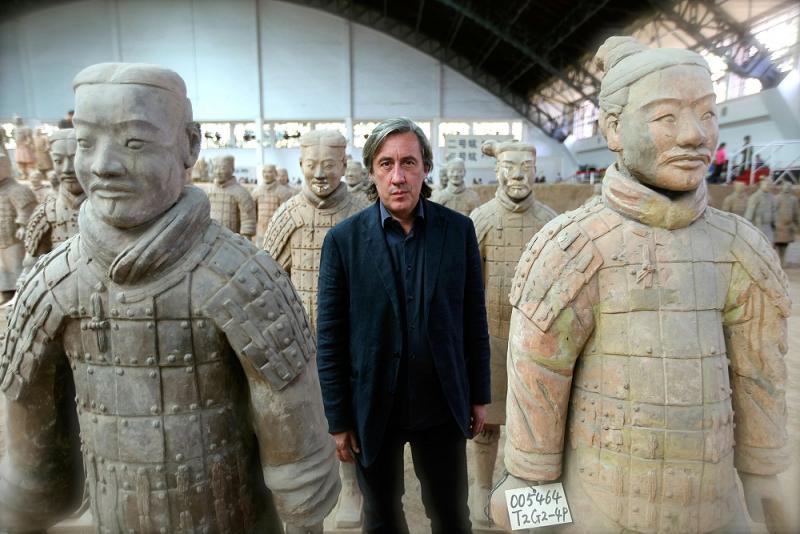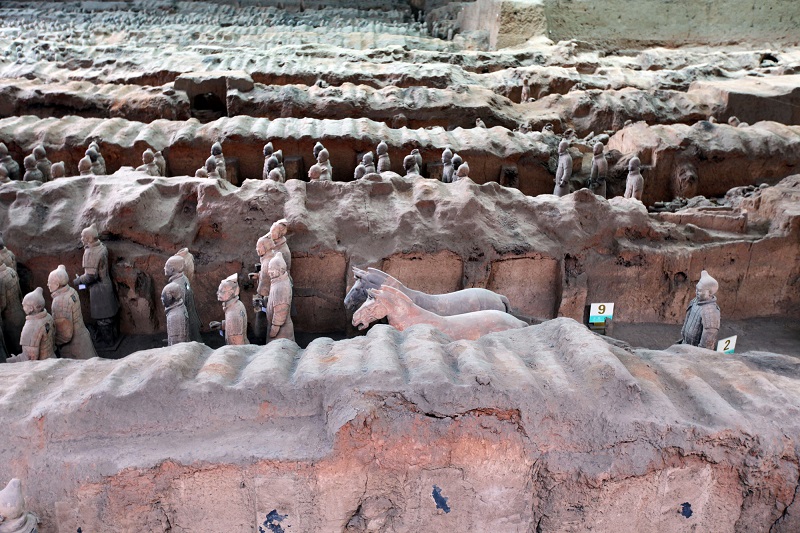Art of China, BBC Four | reviews, news & interviews
Art of China, BBC Four
Art of China, BBC Four
Andrew Graham-Dixon's series offers so much more than the title suggests

If, like me, you switched this on feeling sheepish about your sketchy knowledge of Chinese art, you would have welcomed as a ready-made excuse the news that some monuments synonymous with Chinese culture are relatively recent discoveries.
We have all seen those eerie pictures of the ranked thousands of sculpted soldiers looming out of the darkness and they are highly evocative, but Andrew Graham-Dixon's wonderful reaction did far more to convey the insane, mindboggling scale of the spectacle. He exclaimed, “It’s like King’s Cross!”, before continuing the rush hour theme: “Here they are. The imperial guard, the terracotta army lined up for all time like commuters waiting to travel into eternity.”
Any culture's history of art tends to be rooted in anxieties about the afterlife
What you won’t have seen before is any human being photographed in amongst this ancient treasure, still less anyone giving a terracotta soldier a sideways look before referring to it as “a guy”, but this is all part of the Graham-Dixon experience. His ability to negotiate such access to the objects discussed is all to the good, because he was able to show us that each one of these lifesize sculptures is an individual, the ethnic diversity of these legions of thousands emphasising the sheer extent of the first Emperor’s rule. He showed us the maker’s marks left on each soldier; first the mark of the craftsman who made it, then the stamp of approval from his supervisor. And it was here we saw a glimpse of the roots of modern Chinese bureaucracy. Running this vast country united for the first time under one ruler, carrying out “the most perfectly totalitarian artistic vision the world has ever seen”, required a highly efficient administration.
It is in these moments of recognition, where the world of today is echoed in the ancient past, that history, and indeed art history, comes alive, and Graham-Dixon is exceptionally good at flitting across millennia, weaving in asides from modern-day China and allowing the tone of the whole to ebb and flow with humour and insight.
In its realistic representation of the human figure in sculpture, the terracotta army (pictured below) betrays the influence of the West and even well over 2000 years ago, the silk routes that allowed international trade to thrive enabled the exchange of ideas as well as goods. The sight of Graham-Dixon stumbling across windswept sand dunes somewhere in the back of beyond seemed to me unaccountably funny, but his lone figure, at times almost lost from view as he was engulfed by a sandy blast, provided a gutsy demonstration of the hazards of the silk route. At times, he told us, “the only way you would know you were on the right route was because you would come across a little heap of bleached human bones.” You got the feeling he thought he might be heading that way himself.
 It was no surprise that the opening episode, the first in a three-part series, found itself, for the most part, concerned with the commemoration of the dead. After all, any culture’s history of art tends to be rooted in anxieties about the afterlife. To this day, the Chinese make offerings to their ancestors of “plates of flyblown food”, and Mr Yang’s Emporium, a bizarre place a bit like a scrapyard, or a bring-and-buy sale, provided Graham-Dixon with the perfect modern-day counterpart to the terracotta army. Mr Yang makes tributes from card and paper for people to burn as offerings to the dead. There was a Mercedes, a computer on a desk, and a dog, but the real fun started when Graham-Dixon found a cow apparently made from cardboard and yellow tissue paper. Getting in close for a detailed inspection he exclaimed, “It’s got an udder!”, before remembering that this was on television and hurriedly moving off.
It was no surprise that the opening episode, the first in a three-part series, found itself, for the most part, concerned with the commemoration of the dead. After all, any culture’s history of art tends to be rooted in anxieties about the afterlife. To this day, the Chinese make offerings to their ancestors of “plates of flyblown food”, and Mr Yang’s Emporium, a bizarre place a bit like a scrapyard, or a bring-and-buy sale, provided Graham-Dixon with the perfect modern-day counterpart to the terracotta army. Mr Yang makes tributes from card and paper for people to burn as offerings to the dead. There was a Mercedes, a computer on a desk, and a dog, but the real fun started when Graham-Dixon found a cow apparently made from cardboard and yellow tissue paper. Getting in close for a detailed inspection he exclaimed, “It’s got an udder!”, before remembering that this was on television and hurriedly moving off.
All this, and it calls itself Art Of China. As a title it's certainly catch-all, but it completely fails to do the show justice. Unlike most television presenters, Andrew Graham-Dixon is not afraid to get stuck in – just look at his hopelessly impractical linen jacket, which became increasingly crumpled and dusty as the hour wore on. If the series continues like this, he’ll be needing several new ones.
rating
Share this article
The future of Arts Journalism
You can stop theartsdesk.com closing!
We urgently need financing to survive. Our fundraising drive has thus far raised £49,000 but we need to reach £100,000 or we will be forced to close. Please contribute here: https://gofund.me/c3f6033d
And if you can forward this information to anyone who might assist, we’d be grateful.

Subscribe to theartsdesk.com
Thank you for continuing to read our work on theartsdesk.com. For unlimited access to every article in its entirety, including our archive of more than 15,000 pieces, we're asking for £5 per month or £40 per year. We feel it's a very good deal, and hope you do too.
To take a subscription now simply click here.
And if you're looking for that extra gift for a friend or family member, why not treat them to a theartsdesk.com gift subscription?

Add comment